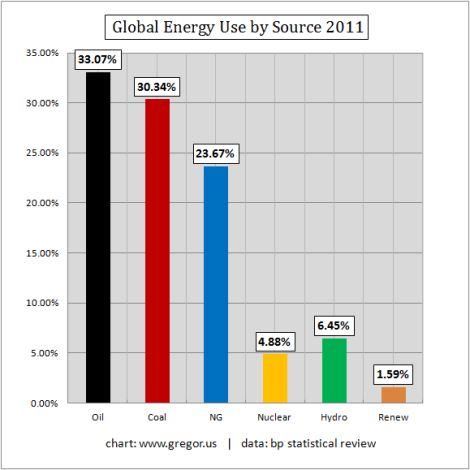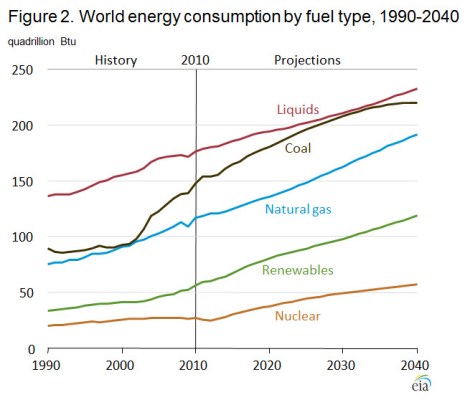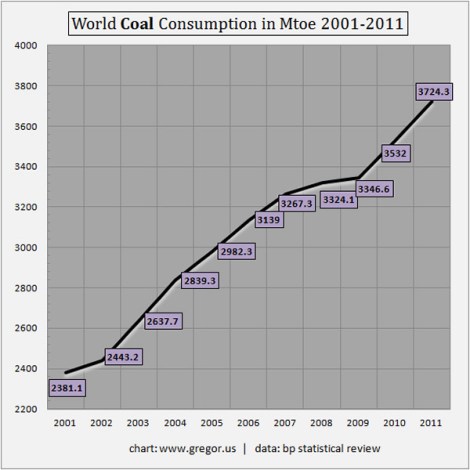In my last post, I referenced a new report from Goldman Sachs analysts showing that the market for seaborne thermal coal (overseas imports and exports used to fuel power plants) is likely to fall from 7 percent annual growth to around 1 percent, and stay there for the foreseeable future. This is great news, in that it has the potential to render several new large-scale coal-extraction projects around the world — including export terminals in the U.S. Pacific Northwest — unprofitable before they are completed or, in some cases, begun.
However, this bit of good news should not distract from the larger picture, which is decidedly grim. As oil prices remain stubbornly high, the rapidly urbanizing developing world has turned to coal, which has been growing at a furious pace and is on the verge of becoming the world’s primary energy source. Even if its momentum is slowing slightly, it remains a world-crushing behemoth.
No one has been following this story more closely than energy analyst Gregor Macdonald. This is from his blog:
Yikes! As Macdonald writes, “Only a very small portion of the global public is aware that global coal consumption has advanced by over 50% in the past decade.”
By 2011, coal represented 30.34 percent of total global energy use, according to the BP Statistical Review, just a few points shy of Old King Oil:

Gregor.usClick to embiggen.
What’s more, while coal’s hyper-growth may be slowing slightly, many of the long-term drivers behind it remain firmly in place. In particular, as developing-world urbanization pushes more global energy demand into cities, the balance of power (as it were) shifts to electrical grids, precisely where coal is strongest.
In China, coal expansion is slowing in part due to small, inefficient plants being closed, but as Michael Davidson explains (in a great series on energy in China), shifting to bigger, more efficient, longer-lived plants may lock in a coal “floor” in China for many decades to come.
It’s worth noting that the U.S. Energy Information Administration (EIA) is somewhat more bullish on coal than Goldman Sachs. According to its 2013 International Energy Outlook, in the absence of strong climate policies, coal will grow … well, a whole sh*t ton. Climate Progress reports:
If business as usual continues for the world’s climate policy, the EIA’s mid-range projections show consumption of coal — the dirtiest fossil fuel in terms of carbon emissions — increasing by over a third by 2040. It nearly doubles by that time under the worst case scenarios. Specifically, the EIA’s “Reference Case” projects global coal consumption jumping from 147.4 quadrillion Btu of energy in 2010 to 219.5 in 2040. … But looking across the range of scenarios the EIA lays out, coal consumption could only reach 182.2 quadrillion Btu by 2040 — or go as high as 297.3 quadrillion Btu.

EIAClick to embiggen.
Even the low end of that range is scary as hell. When we talk about a decline in global coal’s growth rate, it’s crucial to remember that even a small percentage of a gargantuan amount is … a lot. When I ran the Goldman Sachs report by him over email, Macdonald pointed out that the analysts forecast growth in global coal demand from 5,564 million tons per anum in 2013 to 6,564 mtpa in 2017. That’s relatively slow growth, percentage wise, but in absolute terms it is 1,000,000,000 more tons of coal a year being burnt. “This is some serious BTU growth,” Macdonald says.
The global coal juggernaut is so large now that even a low rate of growth represents an enormous amount of new greenhouse gas emissions. Not only that, it represents an enormous amount of new momentum. If there is to be any hope in the long term, the trajectory of coal urgently needs to change. Concludes Macdonald:
A tonne of coal stopped right now by other means, other sources, and preferably renewables, is equal to many, many tonnes stopped in the future. Stop that tonne of coal today and you kill path dependence, beat sunk-cost decision making, and divert the Big River of global energy ten years from now. It’s critical to think in these dynamic terms, as the very large system lumbers forward, with its constellation of politicians, corporations, and myriad other dependencies attaching themselves to whatever system comes into being. Renewables create their own constituency, just like coal. Coal is not special. Change the river now, and you amplify what happens a decade from here.
If we can’t divert that river, if we can’t find some way of urbanizing the developing world with low-carbon power, we are well and truly screwed. Coal must be attacked head on, much more furiously than anyone has yet contemplated, if there is to be any hope of climate stability.



